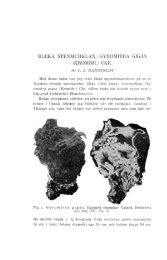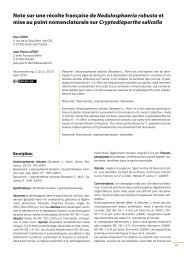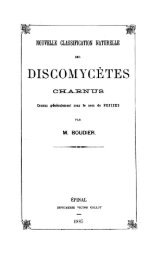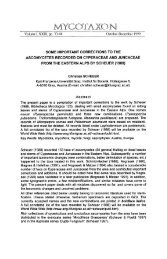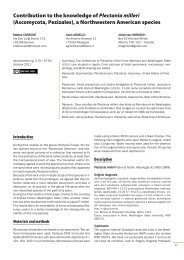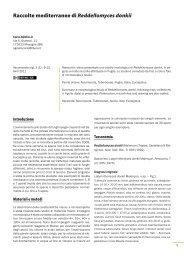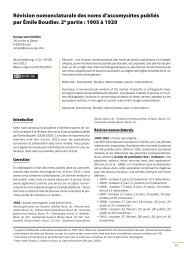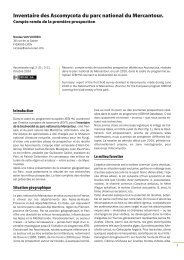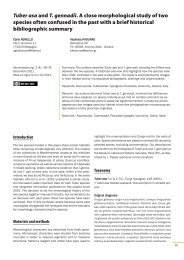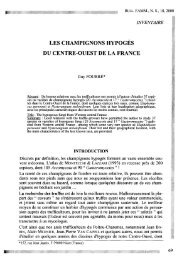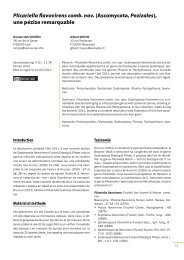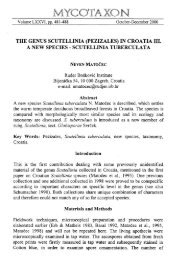AscomyceteOrg 05-01_AscomyceteOrg
AscomyceteOrg 05-01_AscomyceteOrg
AscomyceteOrg 05-01_AscomyceteOrg
You also want an ePaper? Increase the reach of your titles
YUMPU automatically turns print PDFs into web optimized ePapers that Google loves.
10<br />
the name Urnula padeniana after the revision of the type specimen<br />
of Bulgaria mexicana (CARBONE et al., 2<strong>01</strong>3), which should be considered<br />
a member of the “campylospora-complex” being extremely<br />
different from U. padeniana. The species in the Urnula clade show<br />
broad morphological differences with Urnula craterium (type species<br />
of the genus), unveiling the need for further ultrastructural and<br />
cytological studies to uncover yet putative common features.<br />
Phylogenetic inference based on the neotype of the type species<br />
Pseudoplectania nigrella, showed that the genus Pseudoplectania is<br />
well supported as a sister clade to Plectania. BOUDIER (1885) proposed<br />
the genus Melascypha to accommodate Melascypha melaena<br />
(Fr.) Boud. (BOUDIER, 19<strong>05</strong>-1910; BOUDIER, 1907) because of its big size,<br />
the presence of a well differentiated stipe, and the morphology of<br />
external hairs, paraphyses and spores. However, these features were<br />
not considered as relevant by subsequent mycologists who proposed<br />
Melascypha as a synonym of Pseudoplectania. Present results<br />
support this synonymy, and the independence of P. nigrella, P. ericae<br />
and P. melaena. Plectania carranzae, with globose spores, belongs<br />
to this genus — as also stressed by CALONGE & MATA (2002) who,<br />
however, regarded it a synonym of Plectania — and so the new combination<br />
Pseudoplectania carranzae is here proposed. Lastly, during<br />
the final revision of the article we obtained clean ITS and LSU sequences<br />
of some collections perfectly matching (macro-microscopically,<br />
phenologically and ecologically) the species known as<br />
Pseudoplectania sphagnophila (Pers.) Kreisel. Our results, not shown<br />
here, suggest also the independence of this species.<br />
The results based upon the isotype specimen of Urnula helvelloides<br />
prove that this species must be regarded as the type of the<br />
independent genus Donadinia. Results also show that Urnula lusitanica<br />
(≡ Plectania lusitanica) and Paxina nigrella (= Plectania nannfeldtii)<br />
belong to this clade, as already pointed out by CARBONE et al.<br />
(2<strong>01</strong>1, as Plectania sect. Donadinia), and so the two new combinations<br />
are proposed. Unfortunately we have not obtained a complete<br />
ITS and LSU sequence of Plectania seaveri holotype, but a perfectly<br />
clean sequence of ITS2 region was successfully obtained using primers<br />
ITS3-ITS4 (GenBank KC249999). The separate phylogenetic<br />
analysis of ITS1 region revealed that this sequence shows a clear relationship<br />
with genus Donadinia (data not shown), representing an<br />
independent lineage within this clade. Due to its morphological features<br />
(see CARBONE et al., 2<strong>01</strong>2b) and also on this partial genetic result,<br />
it is here transferred to Donadinia as well.<br />
The genus Galiella is well supported by phylogenetic inference<br />
on the basis of the sequences of its type species Galiella rufa previously<br />
stored in GenBank. This genus displays a genetic distance similar<br />
to that of most other lineages in the Sarcosomataceae with<br />
almost no intraspecific variability. Two species formerly included in<br />
the genus, G. javanica and G. celebica, seem to be unrelated to the<br />
type species, and constitute an independent lineage within the Chorioactidaceae<br />
(see the discussion below). The old generic name Trichaleurina<br />
Rehm is here restored for these species, primarily on the<br />
morphological study made by the first author on the holotype of<br />
the type species Trichaleurina polytricha Rehm. Trichaleurina was first<br />
introduced by REHM (1903) as an infrageneric taxon within Aleurina<br />
Massee, including three species. Then REHM (1914) raised it at genus<br />
level, validating it with the new (and only) species Trichaleurina polytricha<br />
from the Philippines. Nannfeldt’s unpublished revision<br />
concerning T. polytricha holotype and also Urnula philippinarum holotype<br />
led him to consider both as synonyms of G. javanica. Our type<br />
studies on the former two cited species confirm that they are<br />
conspecific to each other and definitely congeneric with the species<br />
known as Galiella javanica and G. celebica. Anyway, at present,<br />
we prefer to study more material before state if they are conspecific<br />
to G. javanica. In fact, very small differences in the external hairs<br />
morphology could be useful characters for distinguishing species.<br />
The genus Sarcosoma, the core of the family, is here represented<br />
by a single sequence of its type species Sarcosoma globosum. It<br />
seems to be a clearly independent clade within the Sarcosomataceae,<br />
in accordance with its deviant morphological features (CAR-<br />
BONE, 2009). Sarcosoma latahensis was first invalidly described as<br />
Plectania latahense (PADEN, 1967), then validly assigned to Sarcosoma<br />
by PADEN & TYLUTKI (1969b), and finally transferred to the genus Plectania<br />
by CARBONE et al. (2009). Genetic results allow concluding that<br />
it does not belong to any of these or any other previously described<br />
genera, so the new genus Pseudosarcosoma is here proposed to accommodate<br />
it in the family Chorioactidaceae, as defined by PFISTER et<br />
al. (2008). The latter family has been circumscribed with features<br />
that can be summarized as follows: pigmentation, excipular<br />
construction without gelified tissue, ascospores with cyanophilic<br />
walls or cyanophilic surface ornamentation in the form of ridges or<br />
warts, warted external hairs, and in addition multinucleate ascospores<br />
and cells of paraphyses. It is pretty obvious that Trichaleurina<br />
is deviant from this definition because of its jelly flesh, but matches<br />
in all other respects (e.g. warty spores and external hairs). The main<br />
problem should rise for Pseudosarcosoma which shows smooth<br />
spores, slightly gelified medullary excipulum and smooth external<br />
hairs. As can be seen no morphological striking “chorioactidaceous”<br />
features seem to be present in this new genus, although our results<br />
put it into this family. It is worth to note that the collections studied<br />
by us of Pseudosarcosoma, Neournula and Trichaleurina don’t have<br />
the so-called “hymenial hairs” which, to the best of our knowledge,<br />
are present in the family Sarcosomatacae. The same can be said for<br />
the other genera, which, according to PFISTER et al. (2008) seem to<br />
lack hymenial hairs (or non-septate paraphyses). If this will turn out<br />
to be true, this would be an additional feature to delimit both families.<br />
Finally, with regards to the family Chorioactidaceae, our genetic<br />
studies seem to suggest the independence of the European Neournula<br />
pouchetii (Berthet & Riousset) Paden (BERTHET & RIOUSSET, 1965)<br />
from the American 28S LSU sequences already stored in GenBank<br />
with this name (AY307940). Since this taxon was first described in<br />
Europe, the American lineage could be accommodated under the<br />
species N. nordmanensis Paden & Tylutki (PADEN & TYLUTKI, 1969a).<br />
Both species have been regarded as synonyms since PADEN (1972),<br />
and further studies are surely needed to clarify this preliminary result.<br />
Acknowledgements<br />
We are grateful to the A.M.B. Mycological Group of Mesagne (Brindisi,<br />
Italy) for partly economically supported this study. Wanda Daley<br />
(New Zealand Landcare Research Herbarium, PDD), Georges Barale<br />
(University of Lyon herbarium LY, France) and Jukka Vauras (Turku<br />
Herbarium TUR-A, Finland) for the loans. Andrew Parker (USA), Nicolas<br />
Van Vooren (France), Patrice Tanchaud (France), Seppo Kytöharju<br />
(Finland), Christian Zoldan (Italy), Dr. Kenji Saitoh (Japan),<br />
Carles Roqué (Spain), Aurelio Garcia Blanco (Spain) and George<br />
Konstantinidis (Greece) for providing us relevant collections. Finally<br />
we are grateful to all the authors of the published pictures.<br />
References<br />
AGNELLO C. & CARBONE M. 2<strong>01</strong>2 [2<strong>01</strong>1]. — Appunti di studio su Plectania<br />
melastoma. Rivista di Micologia, 54 (4): 315-337.<br />
ALVARADO P., MANJÓN J.L., MATHENY P.B. & ESTEVE-RAVENTÓS F. 2<strong>01</strong>0. — Tubariomyces,<br />
a new genus of Inocybaceae from the Mediterranean<br />
region. Mycologia, 102: 1389–1397.<br />
ALVARADO P., MORENO G. & MANJÓN J.L. 2<strong>01</strong>2. — Comparison between<br />
Tuber gennadii and T. oligospermum lineages reveals the existence<br />
of the new species T. cistophilum (Tuberaceae, Pezizales). Mycologia,<br />
104 (4): 894-910.<br />
BELLEMÈRE A., MALHERBE M.C., CHACUN H. & MELÉNDEZ-HOWELL L.M.<br />
1990. — L’étude ultrastructurale des asques et des ascospores de<br />
l’Urnula helvelloides Donadini, Berthet et Astier et les concepts<br />
d’asque suboperculé et de Sarcosomataceae. Cryptogamie Mycologie,<br />
11 (3): 203-238.



